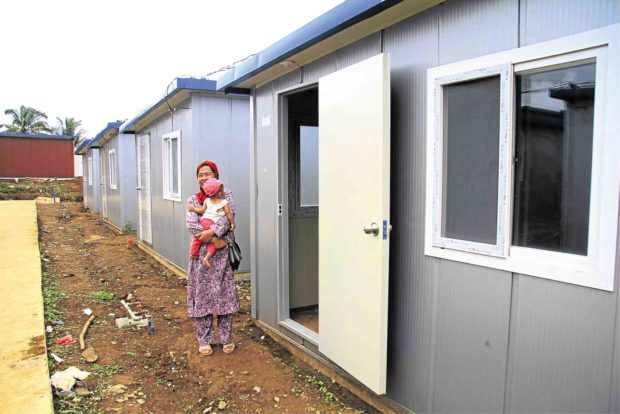
NEW HOMES Some 150 families from the former battle zone in Marawi City have been given temporary shelters in the village of Sagonsongan. —RICHEL V. UMEL
MARAWI CITY — For the past three months, 42-year-old Abdullah Yusoph has been helping build temporary shelters in the village of Sagonsongan here for residents displaced by the five-month war on terror that started on May 23 last year.
But the former tricycle driver from the village of Datu Naga would never live in any of the 1,175 temporary houses that he and his fellow workers built and were still building on the 13-hectare relocation site.
“I was excited working on every unit in the area because I thought that the houses are for displaced families like me,” Yusoph told the Inquirer.
Not qualified
It turned out that under the guidelines crafted by the government, he was not qualified for the houses because, while he fled the city during the war on Islamic State followers, he did not own a house inside the battle zone.
“We only rented space there,” he said.
Farmida Macabando, head of the Association of Barangay Councils here, said it was the government’s technical working group that prepared the guidelines.
“The recipients must have had a house inside ground zero and possess titles to the lots that these houses had been built on. They should also be [classified as] low-income,” Macabando said.
She said recipients should also secure certification from their village chiefs that they were indeed from the villages inside the war zone.
“A family who wanted to get a unit in Sagonsongan should also signify interest to return to Marawi City and should express interest to live in the temporary shelters,” Macabando added.
So on Saturday, Yusoph could only wish his family was among the 150 families that were allowed to move into the temporary shelters in Sagonsongan.
“If he was a tenant in the city before, he should go back to where his house really is because I am sure he had a house in his original town or village here,” Macabando said of Yusoph.
She cited data showing more than 13,000 families had been certified to be from ground zero and relocating them was priority.
Review
Housing Undersecretary Felix Castro, Jr. said officials were reviewing the list because they found that some families had been listed twice.
“We are still reviewing the list since there were double entries,” he said.
Castro said based on projections, only some 11,000 of those in the list might be qualified to occupy the houses in Sagonsongan.
“The families who lived inside ground zero were given priority,” Castro added.
Clara Macabando, 40, said she was grateful for the new house, which was a marked improvement from the tent they left in Pantar town, Lanao del Norte province.
Cleaner
“This is far better. It’s clean here and it’s not humid,” said Macabando, who fled the village of Marinaut at the height of the war last year.
She said the government also vowed to continue helping the settlers even if they had already moved out of evacuation centers.
“They gave us food that would last for 15 days and also money to help us buy some of our basic needs,” Macabando added.
Castro confirmed that families who occupied houses at the relocation site in Sagonsongan got food packs and P15,000 in cash.
Hadji Aslima Mambuwai, 70, said the money would be spent on cooking wares, beds and other household needs.
According to Zia Alonto Adiong, spokesperson for the Lanao del Sur crisis management committee, many displaced residents would not qualify for a unit in Sagonsongan because they do not have titles to land inside the war zone. —Divina Suson and Richel Umel

